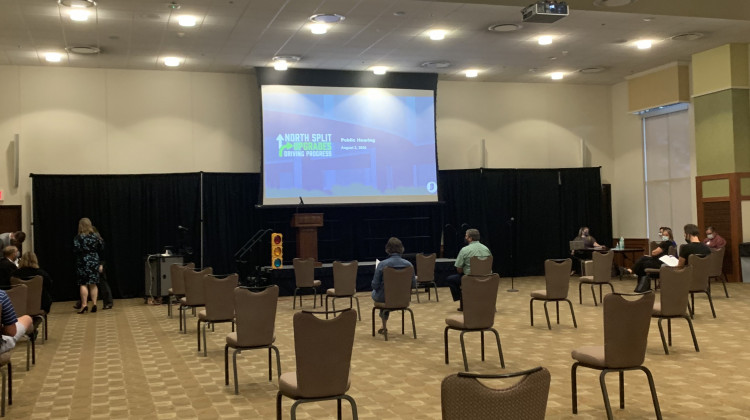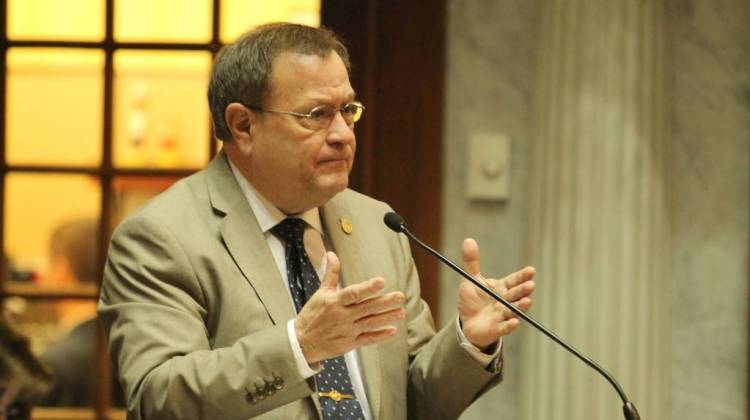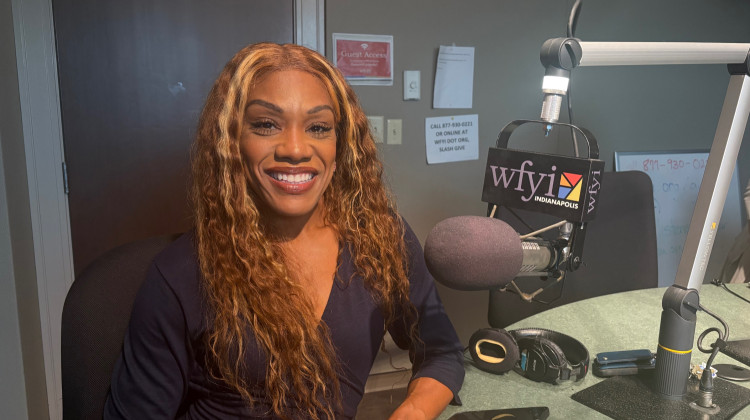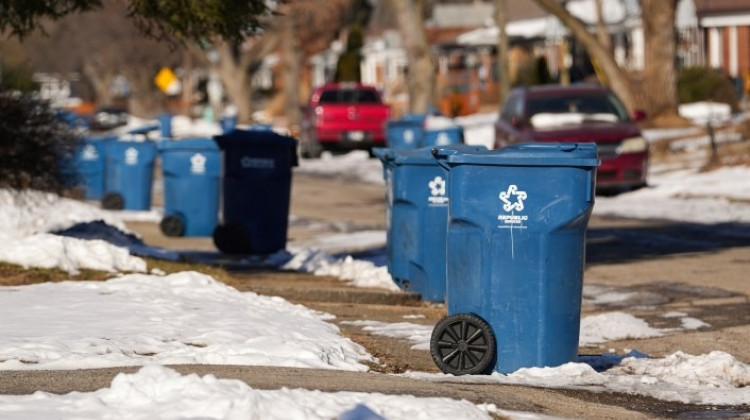This story continues our coverage of INDOT’s public comment meeting last Thursday, updated with Monday’s comments.
Monday Meeting, August 3
The Indiana Department of Transportation held in-person presentations Monday -- the last in a series of meetings to collect public comments on the North Split Reconstruction Project. People can still submit comments in writing, online or through a toll free number until August 17.
Project team leaders discussed an environmental assessment of the project, its aims and proposed plans. An estimated 25 people attended the presentation at the Ivy Tech Community College Culinary and Conference Center.
Concerns expressed at the meeting included a call for employment opportunities for local contractors and examples of how repairs may perpetuate the neighborhoods’ isolation, caused by construction of the highway in the 1960’s. Three people submitted public comments Monday. The comments are representative of earlier public feedback on this project, especially from various historic neighborhood associations. INDOT will send all formal comments to the Federal Highway Administration, FHWA, for consideration.
Monday’s comments are included in this next section, unedited, with more explanation in the following sections about the project’s purpose, the stage it is currently in, next steps and how to continue to submit public comments.
Comments For The FHWA
Carlette Duffy
“How does this affect the crossover or the weave coming from I-70 getting off on West Street, because that’s my neighborhood and I travel that way a lot, so will that break that off? If so, then where are the conversations with Ransom Place and the historic homes that are there that would be affected by that? Also, typically what has happened in the past with contractors that are engaged in this process is that most of them are union, which is great but what typically happens if they don’t have the personnel in the area to hire from in their union pools, then they’ll go to surrounding states. For two years worth of work, people will be willing to come for that. But we have such a drastic need right here in the city of Indianapolis, what can we do to encourage the contractors, not only the ones that are union to work in the area, but those who are minority contractors in the area that they will be offered opportunities in this. So, looking for employment opportunities for those who are working and living in Indianapolis and also for those companies that could potentially participate."
Jacob Bower-Bir
“My comment is this: You got this logo, Driving Progress. I think it’s supposed to mean we’re driving progress, transportation. But what this project says to me is that it’s driving progress, this is progress for drivers. You know, because real progress, a broader meaningful progress and a broader understanding of transportation would not be doubling down on this highway that cuts through the center of our city and suggests that Indianapolis is a good city to drive through. We should be repairing that scar that exists. It’s this concrete. It’s this strain on the environment. It’s segregated our city more than it already was, and it makes it hard today to interconnect and enjoy the neighborhoods that would otherwise constitute the greater downtown area. My broader fear is that as an agency, INDOT is not about transportation, it’s about cars. It’s about moving cars, specifically, quickly and it’s not integrated well with the urban fabric that is Indianapolis. It is also that we will be trapped in this 1960’s and 70’s mindset that by doubling down on this project and making these repairs, we are committing ourselves to this highway for longer instead of doing something many other cities, cities like Phoenix, they are finding ways to build over their highways and build better highways underground or existing highways on top of ground, build over them, or clever solutions that make sense in 2020. We’re doing repairs that were engendered by construction techniques from the 1960’s and 70’s and I feel like we’re still designing like it’s the 1960’s and 70’s.”
Nathan Bower-Bir
“I was heartened to see the environmental justice impact assessment that was conducted and, as you noted, there were no disproportionate impacts on minority or low income populations identified. However, thinking on the divisions that the existing highway put into our city, that further segregated our city, and several of those historic neighborhoods, I wonder whether that assessment was historic looking as well. Because I think that it could be that initial construction did disproportionately affect minority or low income populations and the continued existence of it maintains that historic injustice. And, so, while doing these repairs or this reconstruction may not introduce new disparities, it very likely continues existing ones.”
Concerns and Hopes
The project is intended to improve overall safety and increase traffic capacity by eliminating congestion and potential danger caused by cars weaving between each other to change highways or exit to the city.
The I-65/I-70 northeast interchange split was constructed in stages from 1968 to 1976, and most of its original infrastructure still stands. INDOT plans to repair, and in some cases completely replace, bridges and pavement. Spokesperson Mallory Duncan said it’s time to rethink what’s known as “the North Split."
“How can we make it safer? How can we increase capacity and how can we rebuild the North Split to maintain its life? So, those are the big reasons that this project was necessary, but the main one is that it’s 50-years-old, and it’s time for a change and time for us to maintain that asset,” Duncan said.
When talks of I-65/I-70 reconstruction began, a coalition of various organizations and businesses near the interchange joined to create Rethink 65/70.
Member of the Historic Urban Neighborhoods of Indianapolis (HUNI) Marjorie Kienle said the community is most concerned about the connectivity of neighborhoods and economic development opportunities.
“We know from history, all over the country, that these interstates, when they were first built, destroyed downtowns, destroyed neighborhoods, pushed people out, divided one neighborhood from another, and in many cases divided neighborhoods from themselves,” Kienle said.
Kienle also said the only way for neighborhoods and communities to be reconnected once again would be through a complete upgrade of the interchange underpasses. Rethink hopes for the inclusion of an urban forest and a more inviting design of the underpasses through well-lit pedestrian walkways and public art.
There are a number of professionals in Rethink working with and giving suggestions to engineers in the North Split project team. To address the concerns of the community, the project team established the Community Advisory Committee (CAC) and Environmental Justice Working Group to assist in the decision making process keeping the community in mind. The CAC is made up of 70+ representatives within government, neighborhoods, large employers, schools and community interest groups.
Where Are We Now In The Project?
The Indiana Department of Transportation is assessing the environmental impact of the North Split Project. The assessment considers the effects on historic districts and neighborhoods, highway noise, environmental justice, and traffic impacts of construction.
Issues currently considered include: Which exits and entrances are expected to have more traffic if others are eliminated? And since Michigan gets quite congested, is there a plan to address this with the expected increase in traffic?
Some people voiced concerns about access to certain parts of the highway and the potential construction delay because of the pandemic.
In addition to the environmental impact assessment, INDOT will send public comments and responses to the Federal Highway Administration (FHWA) for further evaluation. FHWA will review the plans and public input to determine whether the project poses no significant impact, or it will request INDOT to make an Environmental Impact Statement (EIS) to justify the need for the project.
The Preferred Alternative
The project team proposes it move forward with what they call “Alternative 4C.” That has already been reviewed to determine it meets the project's purpose and needs.
Engineering Lead Seth Schickel said the main need is eliminating weaves at the Delaware and Pennsylvania Street ramps.
In the proposed plan -- there would be access to the Pennsylvania Street off-ramp from I-65, but not from I-70 East, as there is today. Instead, the traffic would divert to the Michigan and Ohio Street ramps and to West Street. As for Delaware Street, there would still be access to I-70 from the Delaware entrance ramp, but there would no longer be access to I-65 and the Collector-Distributor Road -- which leads to North Street, Michigan Street, New York Street, Ohio Street and Fletcher Avenue.
“It has a smaller and more compact footprint than the existing interchange does. We were able to accomplish this interchange design with minimum widening, with shorter walls, and, again, it can all be done within the existing property that INDOT already has,” Schickel said.
INDOT analyzed a total of five alternatives, which were reviewed by the public in fall 2018. The alternatives ranged from no building to adding more through lanes and large retaining walls. Other alternatives looked like they could meet the purpose and need for the interchange, however major impacts to nearby communities and neighborhoods made them less appealing.
Next Steps
If the FHWA determines it approves INDOT's prefered plan, after the completion of the Environmental Assessment phase and review of public comment, the project team will continue the design and construction phases.
“We are anticipating that construction will start later this year,” Duncan said, “but it all depends on that environmental process.”
Construction completion is anticipated in 2022, possibly rolling over to 2023.
Comments And Questions?
Comments and questions can be submitted via email at info@northsplit.com, North Split Website Contact Form, PO Box - PO Box 44141, Indianapolis, IN 46244, and by leaving a no more than two-minute message on the toll-free phone number - 1-877-799-6570.
 DONATE
DONATE







 Support WFYI. We can't do it without you.
Support WFYI. We can't do it without you.